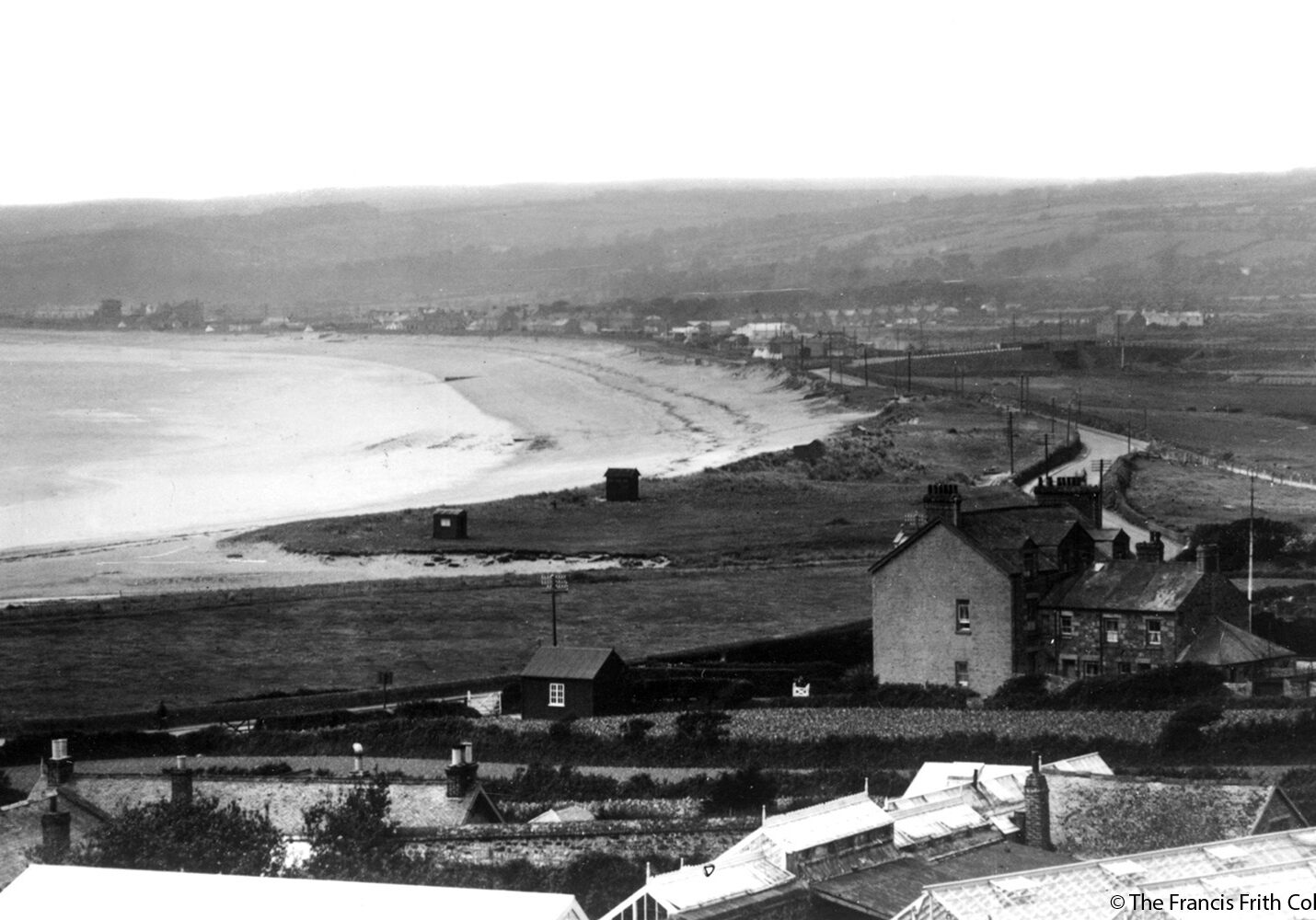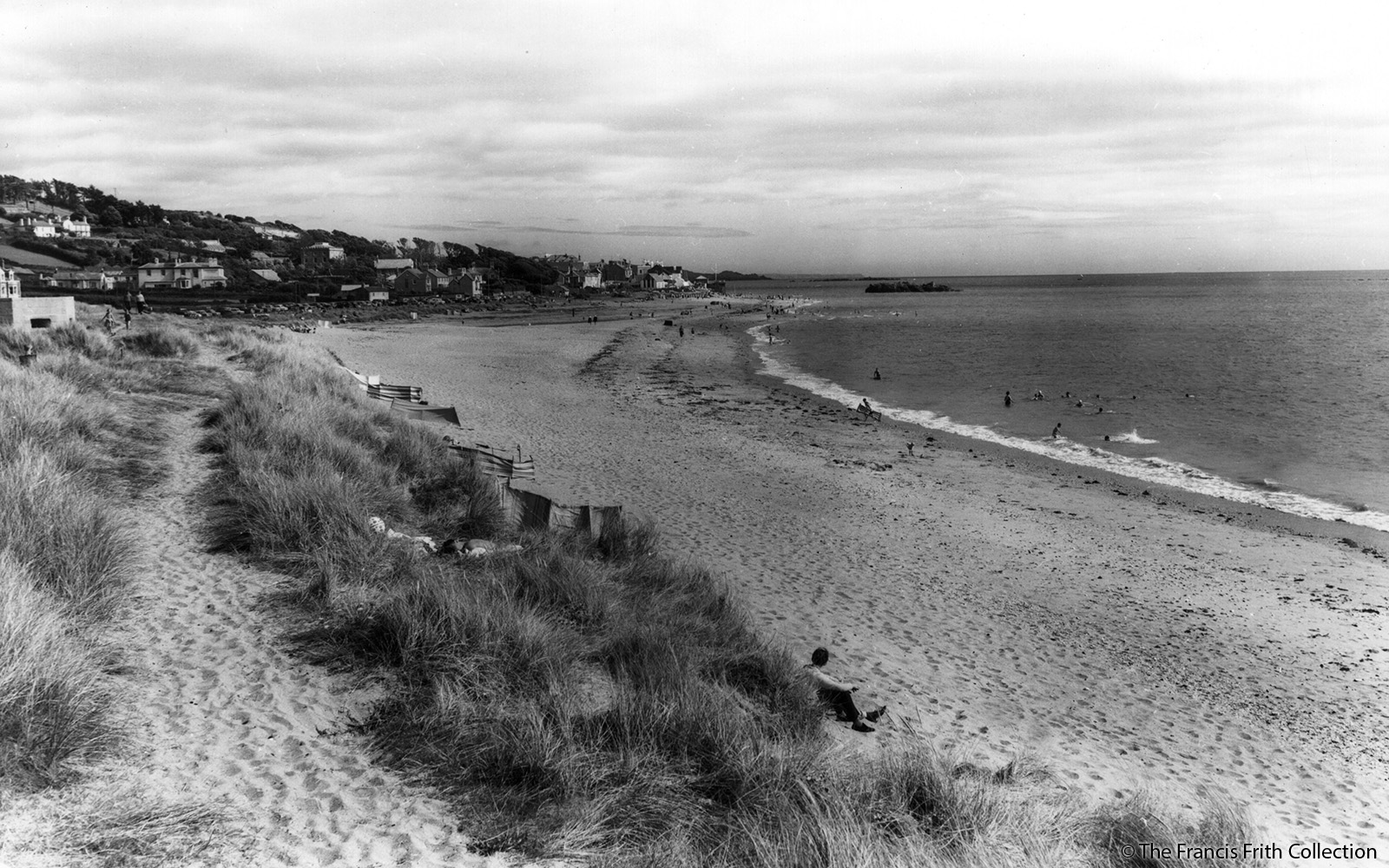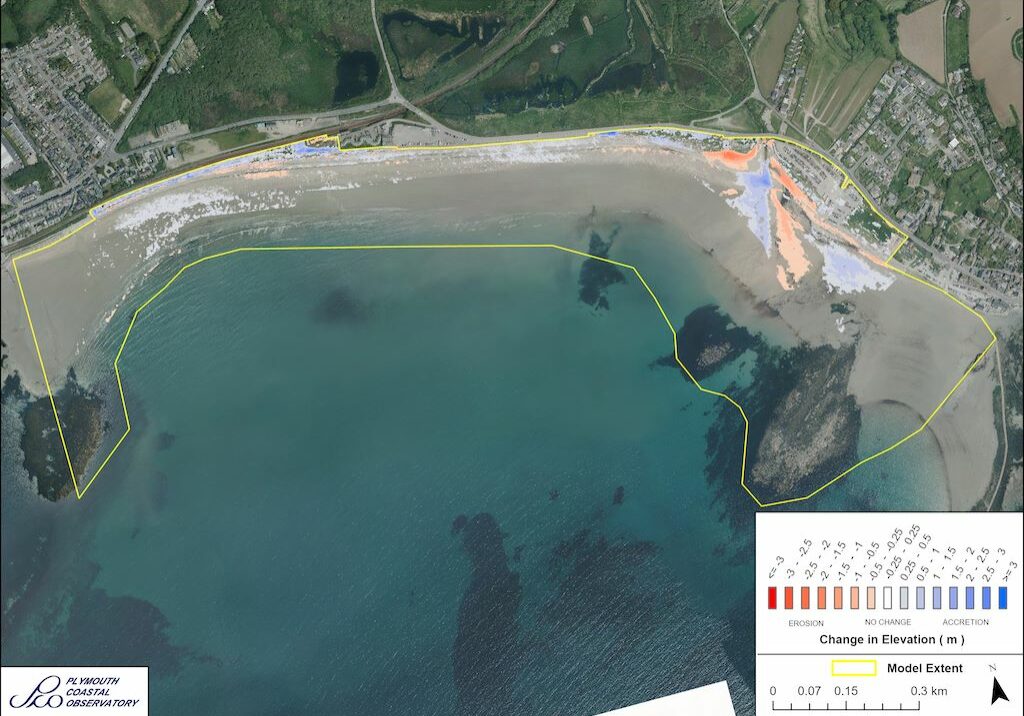
Marazion (Cornish: Margas Yow, meaning ‘Thursday Market’ or Margus Byghan, meaning ‘little/small market’) is a south-west facing beach within Mounts Bay, on the south-west coast of Cornwall. The Marazion River flows onto the beach and also feeds into the Marazion Marsh, an important and highly designated wetland environment.
The westerly end of Marazion Beach, as it joins with Long Rock, tends to be a mixture of sand and shingle above high water, but a fine flat sandy beach at low water. Below the town, in the vicinity of the causeway and Chapel Rock, there is little or no beach at high water. As the tide drops it exposes a substantial area of sand that stretches all the way to the Harbour on the St Michael’s Mount. There are a number of substantial rocky outcrops associated with the Bay, such as Little and Great Hogus to the north-west of the Mount and Top Tieb to the north-east.
With the exception of a short section of constrained and confined dunes, the location is dominated by a variety of seawall structures, which protect the historical market town of Marazion. The boundary between the natural and built environment leaves little space for the coastline to rollback, making some parts of Marazion more vulnerable to storm surges and more sensitive to sea level rise.


Coastal Change
The coastline of Cornwall is an ever-changing environment. It is energetic, dynamic, never still and changes with each wave and each tidal cycle. Some of the changes we see are gradual and barely noticeable, whilst others, such as rockfalls, happen suddenly and often shockingly.
From one visit to the next it can sometimes be difficult to see how a beach and dune system has changed, but information has been collected, and is being collected through the Making Space for Sand project, to help us better understand how the coastline is changing. The purpose of this section of the website is to understand each location has changed over time, how it could change in the future and understand the policies that influence how we can respond to these changes.
Shoreline Management Plans (SMP)
The Shoreline Management Plan (SMP) is a strategic planning and management assessment tool that helps identify and measure the risk associated coastal erosion and coastal flooding. The document makes a number of policy recommendations over short, medium and long term timeframes setting out a strategic approach to managing the built, natural and historic environments associated with the coastline. Within SMP there are four policy approaches which have been assigned to stretches of coastlines. The four policies are: No Active Intervention (NAI), Hold the Line (HTL), Managed realignment (MR), and Advance the line (ATL).
Marazion sits within Policy Development Zone 8 (PDZ8), in Management Area 19 (MA19), within Policy Units (PU) 19.2, 19.3, 19.5 and 19.6. The policy recommendations for these policy units are detailed in the table below and the SMP can be accessed through the Cornwall Council website.
Use your touchscreen
to scroll the below table
| Policy Unit | SMP2 Policy Plan | ||||
| 2025 | 2055 | 2105 | Comment | ||
| 19.1 | Undefended Cliffs (including southern part of Mount)
Main Policy Sub Policy
|
NAI DnD |
NAI DnD |
NAI DnD |
Important sediment source to intertidal area. NAI meets AONB objectives. Allow natural coastal evolution to occur to support conservation interest of protected sites. The cliffs are also an important sediment source for the intertidal area. |
| 19.2 | Marazion east (Venton Cove)
Main Policy Sub Policy
|
NAI LAO |
NAI LAO |
NAI LAO |
Need to provide transition from NAI of cliffs to the east into to HTL at Marazion Town frontage. Allow natural coastal evolution to occur. This would not preclude local work to existing public or private defences, although as these only or primarily protect the coastal path and access point, risk management is likely to be achieved by re-routing these to a more sustainable position. South West Water assets within the erosion zone mean localised intervention may be needed to slow erosion: this was not originally identified in the SMP so needs to be considered further.
|
| 19.3 | Marazion Town
Main Policy Sub Policy
|
HTL M/R |
HTL M/R |
HTL M/R |
Potential heritage losses & economic impact on local economy under other policies unacceptable. Defences at eastern end may require some extension to prevent outflanking. Maintain defence to Marazion, including properties, heritage interest and South West Water assets within the erosion risk zone. Manage potential risk of outflanking of defences in adjacent undefended areas. Current shoreline position not likely to be technically feasible to maintain beyond the SMP if sea level rise continues at its predicted rate.
|
| Key Main Policy: HTL - Hold the Line, A - Advance the Line, NAI – No Active Intervention MR – Managed Realignment
Sub Policy: DnD – Do not Defend, LAO – Local Activity Only, M/R – Maintain/Replace |
|||||


National Coastal Erosion Risk Mapping (NCERM)
National Coastal Erosion Risk Mapping (NCERM) provides a baseline of coastal erosion, for the coastline of England, over short, medium and long-term timeframes. The data is based on the natural and defence characteristics of the coastline and provides rates of erosion at differing levels of confidence to help better plan for worse case scenarios. The data provided is for guidance and does not estimate the absolute location of the future coastline.
The basic NCERM lines show erosion estimates for the Short Term (ST-20 years), Medium Term (MT-50 years) and Long Term (LT- 100 years). The data is further categorised by probability: 05 is 5% probability (a 1 in 20 chance of being exceeded) Red Shading, 50 is 50% probability of being exceeded (a 1 in 2 chance of being either exceeded or not exceeded) Orange Shading and 95 is 95% probability (a 19 in 20 chance of being exceeded) Yellow Shading. Click the link below to access the Cornwall Council NCERM Mapping site read the about section then click on layers.

Historical Images of Marazion
Historical photographs provide a powerful insight into how the Cornish coastline has changed within the past Century. The Making Space for Sand project are working in collaboration with the Francis Frith collection and have been given permission to share historical images on a number of beaches considered within the project.
In looking back, we can better understand how the coastline has changed, helping us understand not only how the coastal fringe has developed but also the potential future changes that we my observe. When this is considered alongside forecasts of coastal erosion and sea level rise it will help enable us to better adapt to our changing coastline.



Modelling Coastal Change

Using data that has already been collected, combined with data collected through the Making Space for Sand project, a series of models will be carried out at each location. This will help us better understand how each location may respond to sea level rise and gain a deeper understanding of how coastal sediments move and behave.
The complexity of the modelling, and the data collection that helps inform it, means that modelling outputs will not be the same on all sites. Some locations will be more thoroughly investigated to understand more complex issues and provide data that can be more widely applied to other sites with similar characteristics.
As the project develops this section of the website will expand, sharing new reports and coastal change projections when they are produced.
LiDAR surveys, which are explained on the Data Modelling page, have been carried out by the South West Coastal Monitoring program at this location. The image shared here visualises where sand has eroded (areas shaded in red) and where it has built up (areas shaded in blue), between the LiDAR surveys carried out in 1998 and 2019. The darker the shade of red or blue the greater the amount of sand erosion or accumulation has been observed. The image helps visualise that beaches are areas that change shape over time and will continue to do so as sea levels rise.


Beach and Dune Ecology
Beaches and dunes represent an important transition between the marine environment and the terrestrial environment. This transition creates a range of special habitats and exposes a range of interesting features, which that can result in these spaces being highly designated and protected. The Making Space for Sand project will survey a number of dune systems. These surveys will help highlight how they may be changing, will identify rare species, will map invasive species, help us understand overall dune condition and identify potential constraints to improving their condition.
There are a range of designations that recognise a variety of different features. There are also a number of dunes systems where data has been collected to understand their habitat value. These are explored, on a site-by-site basis, in the section below.

Designations
Site of Special Scientific Interest (SSSI)
A Site of Special Scientific Interest or SSSI is a statutory conservation designation notified by Natural England denoting protection for biological and/or geological characteristics. The natural wildlife and geological features of SSSI’s are considered to be irreplaceable parts of the national heritage. These are protected in order to preserve their importance, and to prevent damage and development.
The Marazion Marsh SSSI covers an area of 59.9 hectares and extends over the floor of a wide, level coastal valley and is separated from the coast by a shingle bar and a narrow belt of sand dunes. Marazion Marsh is the largest area of reed-marsh in Cornwall, home to a range of noteworthy plants species and of particular importance for its bird life.
Designated Cornwall National Landscape Area
From November 2023, all areas previously know as Areas of Outstanding Natural Beauty, or AONBs, were re-named National Landscape and in Cornwall became Cornwall National Landscape. However, the Management Plan still references the term AONB as this was formally adopted by Cornwall Council and cannot be amended until the next plan is produced.
Cornwall National Landscape areas are protected landscapes whose distinctive character and natural beauty are so outstanding that it is in the nation’s interest to safeguard them. As such they have been nationally designated by the same legislation as National Parks and have the same status and level of protection.
Image of boats at Cadgwith Harbour (Courtesy of Sue Rowlands)
South Coast Western section of AONB
The South Coast Western section of AONB covers an area of 19,258 hectares, which is 20% of the total AONB area in Cornwall. The key landscape characteristics of the coastal landscape in this area of the AONB is a soft profile. It benefits from the protection offered by the Penwith peninsula against the full force of the Atlantic storms.
Image of resting cormorants in the Helford River (Courtesy of Susan Scott)
Marine Conservation Zone (MCZ)
A Marine Conservation Zone (MCZ) is a type of marine protected area, designated in English, Welsh and Northern Ireland territorial offshore waters, to protect a range of nationally important, rare or threatened marine habitats or species by halting or reversing damage and degradation caused by human activities.
The Mounts Bay MCZ covers an area of almost 12km2, extending along the mean high water mark from Long Rock to Cudden Point. This MCZ protects a range of sandy and rocky habitats, both on the shoreline and on the seabed. The range of habitats support a variety of life, which includes worms, anemones, starfish and sea squirts found on rocky shores. This site is also important for protecting stalked jellyfish and giant goby.
Image of an anemone attached to seagrass (Courtesy of Susan Scott)

Beach Dune Management Plan
Many of the sand dunes and beaches around Cornwall’s coast are experiencing erosion and sediment loss. This is due, in part, to lack of new sediment input to the shoreline system and rising sea levels. This is a pressing concern as these environments provide protection against the risk of coastal flooding, provide important habitats that cannot be easily recreated elsewhere if lost and help support the regions thriving tourism industry. It is therefore vital that the sand dunes and beaches around Cornwall’s coast are managed in a more sustainable way that balances the combined functions of beach-dune system.
In 2018, Cornwall Council produced Beach Dune Management Plans (BDMP’s) for 10 locations in Cornwall, including one at this location. The aim of the BDMP’s was to:
- Identify the best day-to-day management approach in terms of monitoring and intervention for the beach and dune system.
- Provide a longer-term approach to beach and dune management based upon an up-to-date understanding of coastal processes at the site, as well as predictions of future coastal evolution.
Where possible, the Making Space for Sand project will use these BDMP’s, supported by the data it collects, to work with landowners and environmental groups to help build more resilient and more biodiverse beaches and dunes that will help protect people and place from coastal erosion.
Sign up to Making Space for Sand
If you would like to get involved in helping to make dunes more resilient and biodiverse, want to help develop coastal adaptation and emergency plans or just want to know more about what the project is learning about coastal change, please click here:



